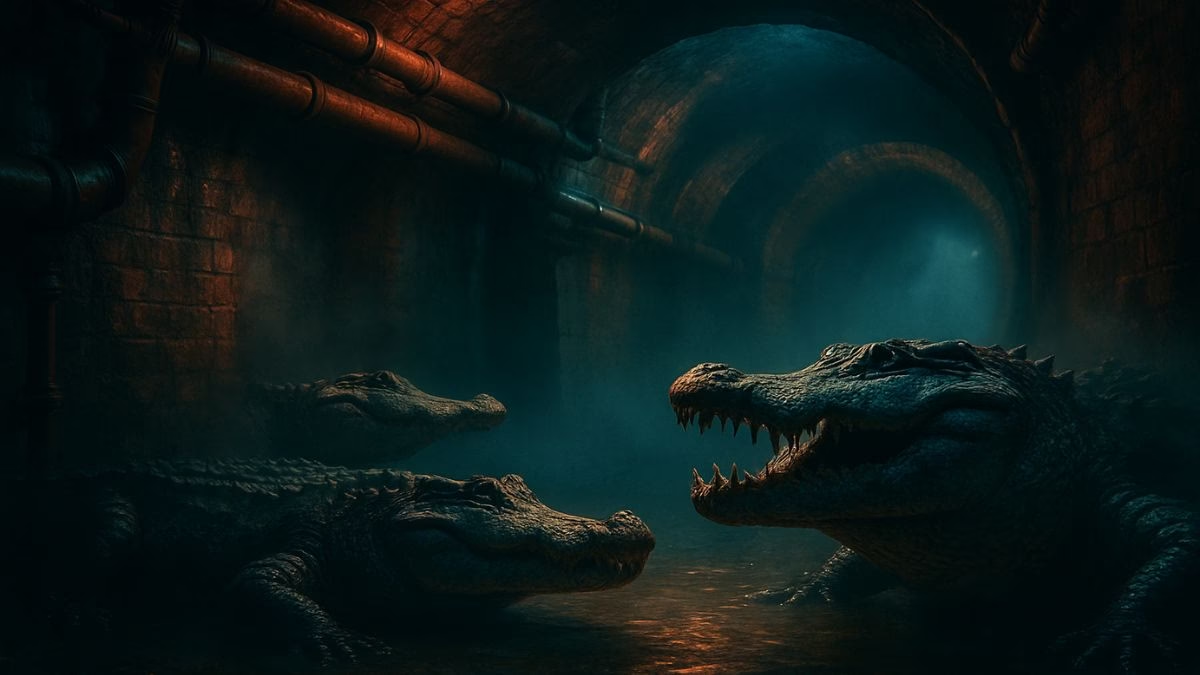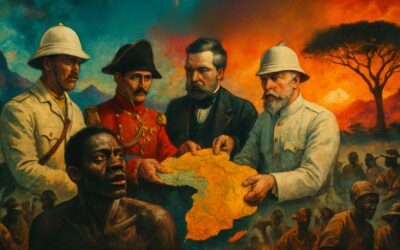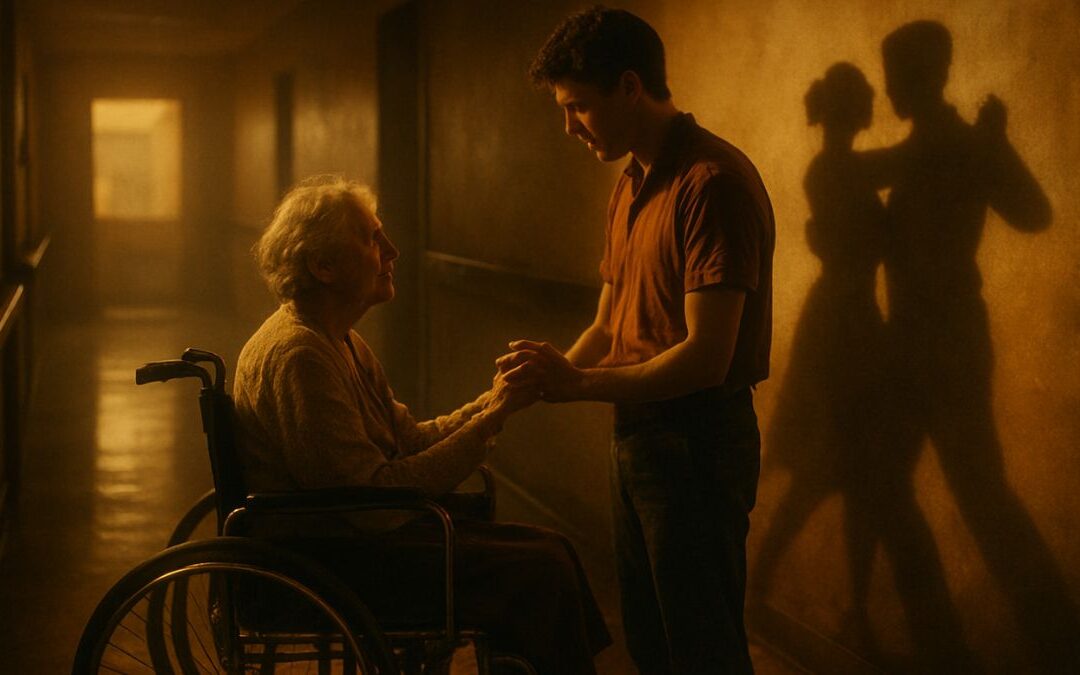- Audio Article
- That Old Chestnut About the Gators
- The Makings of a Modern Myth: What Defines an Urban Legend?
- Down the Drain and Into Reality: The Case of the Sewer Gators
- When the Unbelievable is Documented: Other Legends with a Footing in Fact
- The Psychology of “I Knew It!”: Why We Want Legends to Be True
- The Truth is Down There
- MagTalk Discussion
- Focus on Language
- Vocabulary Quiz
- Let’s Discuss
- Learn with AI
- Let’s Play & Learn
Audio Article
That Old Chestnut About the Gators
You know the one. It’s the story you tell with a mischievous grin, the gold standard of unbelievable tales passed off as fact. It’s the legend of the alligators in the sewers of New York City. We can all picture it: a baby gator, bought as a quirky Florida souvenir, is flushed down a toilet once it nips a finger or outgrows its welcome. Down in the subterranean dark, it doesn’t just survive; it thrives. It feasts on rats and refuse, growing enormous, its scales bleached a ghostly white from the lack of sunlight, a blind, primeval monster lurking beneath the feet of millions.
It’s the quintessential urban legend—dramatic, a little gross, and just plausible enough to make you pause. We tell it, we laugh at it, and we file it away under “Things That Are Obviously Not True.”
But what if we’re wrong? What if, in the murky labyrinth beneath the city that never sleeps, there really were alligators?
This is the fascinating, blurry space where folklore and fact collide. Most urban legends are just that—legends. They are modern parables, cautionary tales that reflect our collective anxieties. But every so often, a story that seems too wild to be anything but fiction turns out to have a solid basis in reality. These rare cases are more than just curiosities; they peel back a layer of our mundane world to reveal something surprising, and they tell us a profound truth about our own desire to find the extraordinary hidden within the ordinary.
The Makings of a Modern Myth: What Defines an Urban Legend?
Before we venture into the sewers, let’s quickly re-establish what an urban legend is. It’s a piece of modern folklore, a story that circulates as true, often happening to a “friend of a friend.” Unlike ancient myths, it’s set in our recognizable world of cars, hotels, and, yes, plumbing. These tales act as cultural barometers, measuring our fears. Fear of contaminated fast food, fear of criminals hiding in the back seat of our car, fear of the hidden dangers lurking within the very infrastructure of our urban lives.
We instinctively dismiss them because they feel a little too perfect. The narrative is too neat, the irony too thick, the ending too shocking. Real life, we assume, is messier and far more boring. But reality, on rare occasions, has a funny way of producing a story so strange that it’s just begging to be turned into a legend.
Down the Drain and Into Reality: The Case of the Sewer Gators
The story of the New York sewer alligators is perhaps the most famous example of a myth with a surprising pedigree. Let’s break down where the folklore ends and the fact begins.
The Legend as We Know It
The canonical version of the legend is a masterpiece of storytelling. It typically begins in the early 20th century, a time when selling baby caimans and alligators to tourists was a popular, and largely unregulated, practice in Florida. Vacationing New Yorkers would bring these tiny reptiles home as exotic pets. But the cute, palm-sized creature inevitably grows into a formidable predator. Panic sets in, and the toilet becomes the disposal unit of choice. From there, the legend takes its famous turn. In the warm, damp sewers, these flushed pets form a colony. Generations are born in the darkness, leading to the evolution of the iconic albino sewer gator, a creature of mythic proportions.
The Kernel of Truth
This all sounds like pure fantasy, a perfect metaphor for the wild, untamable nature hidden beneath a civilized city. It would have remained that way if not for one man: Teddy May. In the 1930s, May was the Superintendent of Sewers for New York City, a man who knew the city’s underbelly better than anyone. On February 10, 1935, an article in The New York Times reported on his incredible findings. May recounted that his workers had been telling him stories of seeing alligators in the storm sewers for years, tales he had always dismissed.
Then, one snowy day in Harlem, his crew was working in a sewer when they saw something alive in the beam of their flashlights. It was an alligator, about two feet long. They lassoed it and, according to the report, hauled it to the surface, where it promptly died in the frigid air. This was not an isolated incident. Over the next year, May’s crews reported finding and dispatching several more alligators in the sewers, the largest being around two and a half feet. His theory aligned perfectly with the budding legend: they were indeed flushed pets.
Separating Fact from Folklore
So, the legend is true! Well, yes and no. This is where we see the birth of a myth. A real, documented event provides the kernel of truth. Alligators, plural, were verifiably found in the New York sewer system. Teddy May, a credible official, went on the record.
But now, look at the embellishment. The real gators were small, only a couple of feet long—hardly the monstrous beasts of lore. There was no evidence of a breeding colony, nor could there be. Herpetologists today are clear that the conditions in a New York sewer are completely inhospitable for an alligator to thrive. The water is too cold for these cold-blooded reptiles, especially in winter, and it’s filled with toxic chemicals that would poison them. There is certainly no scientific basis for them evolving into a race of blind, albino super-gators.
The legend, therefore, is a massive exaggeration of a bizarre but limited series of real events. The human imagination took a strange fact—small, abandoned pets found in an unusual place—and amplified it into a terrifying tale of a hidden ecosystem of monsters.
When the Unbelievable is Documented: Other Legends with a Footing in Fact
The sewer gator is not alone in its journey from folklore to fact. Several other classic urban legends, told and retold for decades, have been proven to have happened, often in a manner just as gruesome as the story suggests.
The Body Under the Bed (or in the Mattress)
The legend goes like this: a couple checks into a hotel and is assailed by a foul odor. They search the room, complain to the management, maybe even get moved to another room. The story ends when a maid, or the next unfortunate guest, finally discovers the source of the smell: a decomposing body stuffed inside the box spring or hidden under the bed.
This story is a chilling manifestation of our vulnerability when we travel, of the hidden, sordid histories of the anonymous spaces we temporarily inhabit. It is also horrifyingly true. There are numerous documented cases that mirror the legend almost exactly. In 1999, guests at a motel in Atlantic City, New Jersey, complained for days about a terrible smell before the body of a man was found stuffed under their bed. Similar incidents have been reported in Las Vegas, Kansas City, Florida, and California. The reality is not just a basis for the legend; in these cases, the reality is the legend.
The Man Who Mailed Himself to Freedom
This one sounds like something out of a cartoon. The story involves a person, desperate to travel or escape, who folds themselves into a shipping crate and mails themselves to their destination. It’s a tale of incredible risk and claustrophobic terror.
But this legend is rooted in one of the most remarkable true stories of American history. In 1849, an enslaved man from Richmond, Virginia, named Henry “Box” Brown, resolved to escape to the free state of Pennsylvania. With the help of a friend, he had a wooden crate built, just large enough for him to curl into. The box was sealed and shipped via Adams Express, traveling by wagon, railroad, and steamboat. For 27 harrowing hours, Brown was tossed around, sometimes left upside down for agonizing stretches, until he finally arrived in Philadelphia and was delivered to abolitionists. He emerged a free man.
The story doesn’t end in the 19th century. In 2003, a man named Charles McKinley successfully air-freighted himself in a crate from New York to his parents’ home near Dallas, Texas. The legend endures because the desperate ingenuity it describes is a real, recurring human story.
The Psychology of “I Knew It!”: Why We Want Legends to Be True
When a story like the sewer alligators is revealed to have a factual basis, we feel a strange sense of satisfaction. But why are we so eager to find truth in these tallest of tales? The answer lies in our deep-seated psychological needs.
The Allure of a Hidden World
Our daily lives can often feel predictable and mundane. The idea that a secret, more exciting world exists just beneath the surface is an incredibly seductive one. This hidden world might be a subterranean ecosystem of reptiles, a network of government conspirators, or a supernatural reality we only glimpse out of the corner of our eye. When a legend is proven true, it confirms this suspicion. It tells us that the world is not as boring as it seems, that mystery and wonder (and danger) are still possible. It gives us permission to believe in the extraordinary.
Validation and Giving Credence to Folklore
Urban legends are a form of communal knowledge, passed down outside of official channels. When one turns out to be true, it gives credence to the entire system of folklore. It validates the “friend of a friend” who told you the story. It reinforces the idea that we should trust these grassroots warnings, that there is a collective wisdom in these tales that exists apart from science and mainstream news. The feeling is not just “the story is true,” but “our way of sharing stories is valid.”
The Blurry Line Between a Story and a Legend
The truth is that the line between a real event and an urban legend isn’t a sharp one; it’s a blurry, permeable membrane. A real event occurs—a small alligator is found in a sewer, a body is discovered in a hotel, a man mails himself in a box. This event is then retold. With each telling, the details that are less interesting are sanded off, and the parts that are most dramatic are polished and amplified. Henry Brown’s specific, harrowing journey becomes the more general “a man mailed himself.” The handful of two-foot gators found in the 1930s becomes a thriving colony of giant albino beasts. The legend is simply the most potent, memorable, and shareable version of a true story. It is truth that has been transformed into art.
The Truth is Down There
The alligators in the sewers of New York may not be the bus-sized behemoths of our imagination, but their smaller, real-life counterparts are arguably more fascinating. They are a testament to the strange intersections of human behavior and the natural world, a reminder that the consequences of our actions can pop up in the most unexpected of places.
Ultimately, investigating these legends-come-true reveals as much about us as it does about the events themselves. Our desire to believe them, to find the kernel of truth in the fantastical, speaks to a fundamental human need for wonder. We want to believe that there are still mysteries to be solved and hidden truths to be uncovered, even if we have to look for them in the darkest, most unpleasant places. The stories we tell are a reflection of the world we live in, and sometimes, if you look closely enough, the world reflects those strange stories right back at us.
MagTalk Discussion
Focus on Language
Vocabulary and Speaking
Hello and welcome. Let’s take a closer look at some of the language that brought our exploration of fact and folklore to life. The words we choose can mean the difference between a simple statement and a rich, evocative idea. We’re going to explore ten key terms from the article, examining how they were used to navigate that blurry line between myth and reality, and how you can use them to express your own ideas with greater precision and flair.
Let’s begin with the word quintessential. In the introduction, I called the sewer alligator story the “quintessential urban legend.” Quintessential means representing the most perfect or typical example of a quality or class. It’s like saying something is the ultimate, the definitive, the purest form of itself. So, the sewer alligator story isn’t just an urban legend; it’s the one you’d pick if you had to choose a single story to represent the entire genre. It has all the classic elements. You can use this word to describe anything that is a perfect example of its type. For instance, “The little black dress is the quintessential item of a timeless wardrobe.” Or, “With its town square and friendly neighbors, it was the quintessential small American town.” It’s a sophisticated way to say “typical” or “classic.”
Next, let’s look at the phrase basis in reality. We said that some legends “have a solid basis in reality.” A basis is the underlying support or foundation for an idea, argument, or process. So, a basis in reality is a foundation of truth. It doesn’t mean the whole story is true, but that it started from something real. There’s a factual anchor. This is a hugely useful phrase for discussing rumors, stories, or even conspiracy theories. It allows you to acknowledge that there might be some truth without accepting the whole story. You could say, “The movie’s plot has a basis in reality, but most of the dialogue was invented for dramatic effect.” Or, “There’s no scientific basis for his claims.” It’s about the foundation of an idea.
This brings us to the pair of words at the heart of our article: folklore and fact. The article explores the “blurry line between folklore and fact.” A fact is something that is known or proved to be true. It’s objective, verifiable data. “Water boils at 100 degrees Celsius” is a fact. Folklore, on the other hand, refers to the traditional beliefs, customs, and stories of a community, passed down through generations by word of mouth. Folklore is about cultural truth, not scientific truth. It’s about what a story means to a community. Distinguishing between the two is a key critical thinking skill. You could say, “While it’s a piece of local folklore that the old well is haunted, the historical fact is that it was simply abandoned in the 1920s.”
And the line between them is, as we said, blurry. This is a simple but essential adjective. Blurry means something is unclear or indistinct. A blurry photo lacks sharp focus. A blurry memory is one you can’t recall with perfect clarity. When we say the line between folklore and fact is blurry, we mean it’s not always easy to see where one ends and the other begins. A real event happens (fact), and it gets told and retold until it becomes a story (folklore). You can use this word for any situation where things are not clear-cut. “The company’s policies on remote work are still blurry.” Or, “My memory of the evening is a bit blurry.”
Let’s talk about the kernel of truth. We said that a real, documented event provides the “kernel of truth” for a legend. A kernel is the central or most important part of something. Think of a kernel of corn—it’s the seed from which the whole plant grows. A kernel of truth is that small, original fact at the center of a larger, more elaborate story. The sewer alligator legend grew from the kernel of truth that Teddy May really did find some small gators. This phrase is perfect for analysis. You can say, “The rumor about the company downsizing is an exaggeration, but there’s a kernel of truth to it: they are restructuring one small department.” It allows you to dissect a story and find its origin.
Of course, for a legend to grow, you need embellishment. The article states that “the legend is an embellishment of a real… series of events.” An embellishment is a detail, especially an imaginary one, added to a statement or story to make it more interesting or entertaining. It’s the act of decorating the truth. When you embellish a story, you’re not necessarily lying outright, but you are stretching the facts, adding some spice. The giant, albino alligators are the embellishment on the kernel of truth. You can use this word when talking about storytelling. “My uncle is famous for his embellishments; his fishing stories get more dramatic every time he tells them.” Or, as a verb: “He tends to embellish his resume to make his experience sound more impressive.”
Now for a more intense word: gruesome. We described the reality of the “Body Under the Bed” legend as “just as gruesome as the story suggests.” Gruesome means causing repulsion or horror; grisly. It’s a very strong word for things that are shockingly unpleasant, especially involving death or injury. It’s not just scary; it’s stomach-turning. You would use it for the goriest details of a horror movie or the graphic descriptions of a true crime story. “The photos from the accident scene were too gruesome to publish.” It’s a powerful adjective, so you should save it for things that are truly horrible.
Another powerful word is harrowing. We described Henry “Box” Brown’s journey as “harrowing.” If an experience is harrowing, it is acutely distressing or disturbing. It’s about intense suffering, stress, or terror. Gruesome is often visual and physical, while harrowing is more about the psychological and emotional experience. Being trapped in a box for 27 hours is the definition of a harrowing ordeal. You could say, “She gave a harrowing account of her escape from the war-torn country.” Or, “The climbers survived a harrowing night on the mountain during the blizzard.” It speaks to a deeply difficult and stressful experience.
Finally, let’s look at the word credence. The article says that when a legend is proven true, it “gives credence to the entire system of folklore.” Credence is belief in or acceptance of something as true. To give credence to a story is to lend it your belief, to find it credible. It’s a more formal way of talking about belief or trust. You might say, “The discovery of the ancient manuscript gives credence to the historian’s theory.” Or, “I don’t give any credence to anonymous rumors I read online.” It’s about the level of belief or trust you’re willing to place in something.
Now, let’s pivot to our speaking lesson. Today’s skill is crucial for navigating a world filled with information, misinformation, and stories that are somewhere in between. We’re going to practice “Expressing Degrees of Certainty.” Life isn’t always a simple ‘true’ or ‘false.’ Often, we have to talk about things that are partially true, probably true, or true in one sense but not another. Our vocabulary is perfect for this.
Instead of saying “The story is true” or “The story is false,” you can use our words to create a more nuanced and intelligent statement.
- Instead of: “It’s a lie.” Try: “The story is a dramatic embellishment with only a small kernel of truth.”
- Instead of: “It’s true.” Try: “There’s a solid basis in reality for this, which gives credence to the claims.”
- Instead of: “I’m not sure.” Try: “The line between fact and folklore on this is really blurry.”
This isn’t about being evasive; it’s about being precise. It shows that you’ve thought critically about the evidence and can recognize complexity.
So, here is your challenge for this week. Find a topic where the truth is debated. It could be a historical controversy, a current news event with conflicting reports, or even just a juicy piece of local gossip. Your mission is to explain the situation to someone, but instead of taking a hard stance, you must practice expressing degrees of certainty.
- Acknowledge the part of the story that is generally accepted as fact.
- Use a phrase to introduce the uncertainty. For example: “But this is where the story gets blurry…” or “However, many people think that’s an embellishment of what really happened.”
- Explain the alternative theories or disputed parts, using our vocabulary. “Some people give credence to the idea that…” or “While there’s no hard evidence, there does seem to be a kernel of truth to the rumors.”
The goal is to sound like a thoughtful analyst, not a biased debater. It’s a skill that will make you a more persuasive and respected communicator in any conversation. Good luck.
Grammar and Writing
Welcome to the grammar and writing section. Today, we’re going to put on our storyteller hats, but with a twist. We’re not just telling a story; we’re trying to create a piece of modern folklore. The goal is to write something that feels so real, so plausible, that it could easily be passed along as a true story that happened to a “friend of a friend.”
Here is your writing challenge:
Choose a mundane, everyday location you know well—a supermarket, a public library, an office building, a local park, a coffee shop. Write a short story (500-750 words) that presents itself as a true account of a bizarre, unsettling, or unbelievable event that occurred there. Your task is to write in a journalistic or non-fiction investigative style to make your new legend sound as plausible as possible. To do this, you should incorporate specific, realistic details, perhaps even a fake ‘quote’ from an ‘eyewitness’ or ‘official,’ to deliberately blur the line between fact and folklore. The goal is to craft a new urban legend that feels like it could be true.
This is a fantastic exercise in tone and credibility. To pull this off, you need to use language not just to tell a story, but to build a case. Let’s look at some grammatical structures and stylistic techniques that are essential for making fiction feel like fact.
Technique 1: Mastering Appositives for an Authoritative Tone
An appositive is a noun or noun phrase that sits next to another noun to rename it or provide more information. It’s usually set off by commas. This is a key tool in journalistic writing to establish credibility.
- Simple: “An employee found the object.”
- With an Appositive: “Janice Porter, a library assistant who had worked at the branch for over fifteen years, was the first to find the object.”
See how the second sentence feels more real? We have a name, a job title, and a detail about her tenure. This adds a layer of authenticity. As you write, think about how you can use appositives to flesh out your characters and settings. “The incident occurred at the Oak Street branch, a small, underfunded library known for its quiet local history section.”
Technique 2: The Strategic Use of Parenthetical Statements
Parenthetical statements are extra pieces of information inserted into a sentence using either parentheses () or em dashes (—). In non-fiction, these are used for clarifications, asides, or adding interesting but non-essential details. In your legend, they are a secret weapon for making the story feel well-researched.
- For Clarification: “She noticed the book was left on the table—a rare first edition of Moby Dick—long after the library had closed.”
- For Adding Detail: “The security cameras in that wing of the supermarket (which were notoriously unreliable and only recorded in ten-minute intervals) showed nothing out of the ordinary.” This detail both adds realism and conveniently explains why there’s no video evidence, a classic urban legend trope.
Using parentheticals makes it seem like you, the narrator, have done your homework and are providing the reader with all the relevant facts.
Technique 3: Blending Quoted Speech and Reported Speech
To mimic an investigative style, you need to handle sources. This means using both direct quotes and reported (or indirect) speech.
- Direct Quotes: Use quotation marks for eyewitness accounts. This adds immediacy and a human element. It makes it feel like someone was interviewed.
- Example: “‘It didn’t make any sound,’ Porter later told the local paper. ‘That was the strangest part. A book that heavy should have made a thud when it fell. This one was just… there.'”
- Reported Speech: Use reported speech to summarize information or to present facts from a more objective distance.
- Example: “Police Chief Miller stated that his officers had swept the building and found no signs of a break-in.”
A good blend of both makes your narrative dynamic and more believable. It creates the illusion that you’ve compiled your account from multiple sources.
Technique 4: The Art of “Hedging Language”
This is perhaps the most important technique for blurring the line between fact and folklore. Hedging language consists of words and phrases that signal uncertainty or a lack of complete commitment to the truth of a statement. It’s how journalists report on unconfirmed information, and it’s perfect for your legend.
Key hedging words include: reportedly, allegedly, apparently, seemingly, it appears that, according to sources, some claim that.
- Without Hedging: “A secret room was discovered behind the bookshelf.” (Sounds like a simple fact).
- With Hedging: “Reportedly, a hollow space was discovered behind the bookshelf.” (Sounds like a rumor you are responsibly reporting).
- Without Hedging: “The book was written by an unknown entity.”
- With Hedging: “The book was apparently written by an unknown entity, as forensic analysis of the ink and paper yielded no matches to any known manufacturer.”
Hedging language protects you from making a definitive claim, which ironically makes your story sound more credible, as if you are a careful narrator committed to only stating what can be proven.
Putting It All Together
Let’s imagine a paragraph for a legend about a strange occurrence in a 24-hour supermarket:
“The incident, which employees now refer to as ‘The Clean-Up on Aisle Four,’ allegedly began around 3:15 AM. The only eyewitness was Mark Chen, a night-stocker in the dry goods section. According to Chen, he heard a spill and went to investigate. What he found was not a broken jar of pickles but a pool of shimmering, iridescent liquid, smelling faintly of ozone and cinnamon. ‘It wasn’t wet,’ he insisted in a later interview (one he gave on the condition of anonymity), ‘but the floor reflected our faces like a mirror.’ David Peterson, the night manager and a notorious skeptic, dismissed it as a prank. Yet, he confirmed that the substance seemingly vanished on its own before maintenance could arrive, leaving behind no residue—only the strange, sweet smell that reportedly lingered in the aisle for weeks.”
Notice the hedging words, the appositives giving credentials, the direct quote, and the parenthetical aside. These are the tools that will transform your scary story into a plausible legend. Now, go find the strangeness lurking in your local coffee shop.
Vocabulary Quiz
Let’s Discuss
Here are some questions to get you thinking about the strange and fascinating space where stories and reality meet. Discuss them with friends, in a classroom, or share your thoughts in the comments section.
- Before reading the article, did you believe any urban legends were true? Which ones? Has the article changed your perspective on the line between fact and fiction?
- Ideas for discussion: Be honest! Share the stories you secretly thought might be true (e.g., Bloody Mary, poisoned Halloween candy). Talk about what made them feel so plausible. Discuss whether knowing a legend has a “kernel of truth” makes it more or less scary.
- The article argues that we want to believe in these stories because they make the world more mysterious and exciting. Do you agree? What is the appeal of a “true” scary story over a purely fictional one?
- Ideas for discussion: Think about the rise of the “true crime” genre. Why are people so fascinated by real-life horror? Does knowing something “really happened” make it more impactful? Or do you prefer the safety of knowing a story is completely made up?
- The internet has become a massive engine for creating and spreading new legends (often called “creepypastas” or memes). How has technology changed the way urban legends are born and evolve?
- Ideas for discussion: Contrast the slow, word-of-mouth spread of old legends with the instantaneous, global reach of an internet story. Talk about the role of “evidence” like photoshopped images or doctored videos. Is it easier or harder to debunk a legend in the internet age? Think of examples like Slender Man or Momo.
- Think of a local legend from your own town or region. What is the story? What local fears or characteristics does it seem to reflect?
- Ideas for discussion: Every place has its stories—the haunted bridge, the ghost of the old theater, the local cryptid. Share a story from your area and try to analyze it like we analyzed the sewer gators. What is the “cautionary” message? What does it say about your community’s history or anxieties?
- Does a story’s factual accuracy matter more than its message? In other words, if an urban legend teaches a valuable lesson (e.g., “don’t drink and drive,” “lock your doors”), does it matter if the story itself is an embellishment?
- Ideas for discussion: This is a debate about ends versus means. Can a “useful lie” be a good thing? Where is the line between a cautionary tale and a harmful deception? Discuss whether the emotional truth of a story can sometimes be more important than its literal, factual truth.
Learn with AI
Disclaimer:
Because we believe in the importance of using AI and all other technological advances in our learning journey, we have decided to add a section called Learn with AI to add yet another perspective to our learning and see if we can learn a thing or two from AI. We mainly use Open AI, but sometimes we try other models as well. We asked AI to read what we said so far about this topic and tell us, as an expert, about other things or perspectives we might have missed and this is what we got in response.
Hello there. It’s a pleasure to add a few more layers to this fascinating topic. The article did a wonderful job showing how legends can spring from reality, but there are a couple of powerful concepts from the worlds of folklore and media studies that can give us an even richer understanding of this phenomenon.
First, I want to introduce you to an ancient Greek idea called “Euhemerism.” It’s a theory named after a mythographer named Euhemerus from the 4th century BCE. His big idea was that the gods and myths of Greek religion were not pure inventions, but were actually based on real historical kings, heroes, and events. Over centuries of retelling, these real stories were exaggerated and embellished until the human heroes were transformed into gods and their deeds became epic myths. This is, in essence, exactly what we see happening with modern urban legends. Euhemerism provides a historical framework for our analysis. The story of Teddy May finding a few small alligators is the real “historical” event. The legend of the giant, albino sewer monsters is the “myth” that grew out of it. It’s a powerful reminder that our need to transform history into compelling narrative is an ancient human impulse.
Second, let’s talk about a very modern concept that perfectly describes the appeal of these stories: “truthiness.” The term was famously coined by comedian Stephen Colbert, and it refers to the quality of a statement seeming or feeling true, regardless of any evidence or logic. Something is “truthy” if it just feels right in your gut. Urban legends are the kings of truthiness. Does the idea of giant alligators breeding in the sewers make logical sense? No. But does it feel true in a metaphorical sense? Does it feel right that a city as big and complex as New York would have some wild, monstrous secrets hidden in its depths? Absolutely. For many people, the “truthiness” of a legend—its emotional or metaphorical resonance—is far more important than its factual accuracy. We believe it not because it’s proven, but because it confirms a worldview we already hold.
Finally, let’s briefly touch on the life cycle of a legend in the internet age. The process of embellishment that once took years of word-of-mouth retelling can now happen in a matter of hours. A local news station reports a strange but true event on a Monday. By Tuesday, that story is on a Reddit forum, where users are already adding details and proposing theories. On Wednesday, a clever user photoshops an image to go with it. By Thursday, a YouTuber has made a dramatic video about the “unexplained mystery.” By Friday, the embellished, photoshopped, and dramatized version has been shared millions of times on social media and has completely eclipsed the original, mundane facts. The internet acts as a massive, high-speed “legend-tumbler,” polishing a kernel of truth into a perfect, viral myth in record time.










0 Comments